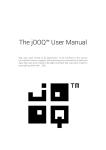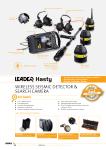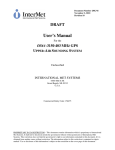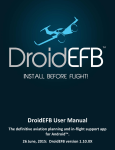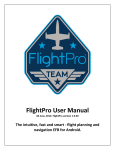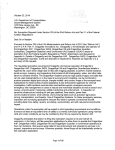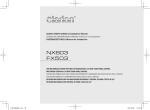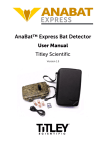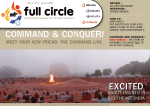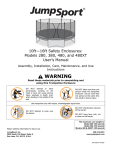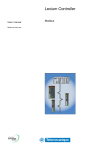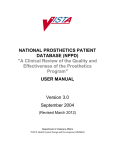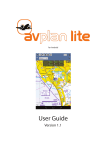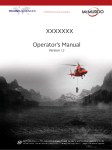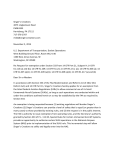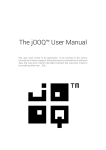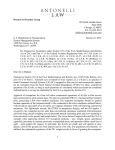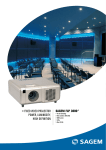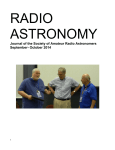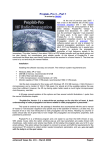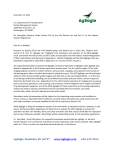Download Gregory_Zonsius_-_Exemption_Rulemaking
Transcript
Gregory Zonsius, Photographer / Videographer, Chicagoland, IL, USA - Section 333 Exemption Petition January 01, 2015 U. S. Department of Transportation Docket Management System 1200 New Jersey Ave, SE Washington, DC 20590 Re: Exemption Request Section 333 of the FAA Reform Act of the Federal Aviation Regulations from 14 C.F.R. 45.23(b); 14 C.F.R. Part 21; 14 C.F.R. 61.113(a)&(b); 91.7(a); 91.9(b) (2); 91.103(b); 91.109; 119.121; 91.151(a); 91.203(a)&(b); 91.405(a); 91.407(a) (1); 91.409(a) (2); 91.417(a)&(b) Dear Sir or Madam, I, Gregory Zonsius, am writing pursuant to the FAA Modernization and Reform Act of 2012 and the procedures contained within 14 C.F.R. 11, to request that I, Gregory Zonsius, an owner and operator of small unmanned aircraft, be exempted from the Federal Aviation Regulations (“FARs”) listed below so that I, Gregory Zonsius, may operate my small ultra-lightweight unmanned aircraft system (“sUAS”) commercially in airspace regulated by the Federal Aviation Administration (“FAA”). As described herein I, Gregory Zonsius, am a photographer / videographer / cinematographer; experienced in flying hobby aircraft for recreational purposes. I have added a quad-copter 1 sUAS to my inventory equipped with a self-contained camera with intent for aerial photography / videography / cinematography; following exemption and approval by the FAA. I have flown small RC electric helicopters for over three (3) years without incident. In addition I have flown multiple sUAS quadcopters for over a year without incident continually practicing to become proficient in the flight characteristics and dynamics of their operations. Committed to safety with each flight. My, Gregory Zonsius', exemption request would permit operation of ultra-light weight, unmanned (piloted by remote control) and comparatively inexpensive sUAS(s) in tightly controlled and limited airspace.2 Predetermined in areas away from general public, airports, heliports and vehicular traffic for community videos, and within property boundaries for individual homeowner for aerial photography/videography. Currently, similar lightweight, remote controlled sUASs are legally operated by unmonitored amateur hobbyists with no safety plan or controls in place to prevent catastrophe. I, Gregory Zonsius, have personally instilled safety protocols and controls 3 to avoid and prevent public hazard, as well as manned aircraft hazards/catastrophe. This will act to further safety protocols exclusive to lightweight sUAS's specific to photography & videography usage as I, Gregory Zonsius, record flight data and other information gained through permitted flight operations to share with the FAA through any required FAA reports to assist with future protocol and safety regulation. Granting my, Gregory Zonsius’, request comports with the Secretary of Transportation’s (FAA Administrator’s) responsibilities and authority to not only integrate sUASs into the national airspace system, but to “...establish requirements for the safe operation of such aircraft systems [sUASs] in the national airspace system” under Section 333(c) of the Reform Act specific to the use of sUASs for photography & videography purposes. Further I, Gregory Zonsius, will conduct my operations in compliance with the protocols described herein or as otherwise established by the FAA. For the reasons stated below I, Gregory Zonsius, respectfully request the grant of an exemption allowing me to operate ultra-light weight, remote controlled sUASs for the purposes of acquiring aerial photos & videos, both of which will promote local economic growth through increased employment and increased tax base. Both with public safety in mind by keeping heavier manned aircraft containing combustible fuel that that poses potential public hazard. Supplemental File – Phantom 2 Vision Plus (User Manual 1.6) & Appendix A Appendix B – Aeronautical Charts 3 Appendix C - Personal Protocols and Controls 1 2 Gregory Zonsius, Photographer / Videographer, Chicagoland, IL USA - Section 333 Exemption Petition Page 1 of 16 Gregory Zonsius, Photographer / Videographer, Chicagoland, IL, USA - Section 333 Exemption Petition I. Contact Information: Gregory Zonsius, ZonCom Productions, Inc. 15402 S. Michael Dr. Plainfield, IL 60544 Office: (815) 676-5275 Mobile: (815) 676-5271 Email: [email protected] II. The Specific Sections of Title 14 of the Code of Federal Regulations From Which Gregory Zonsius Requests Exemption are: 14 CFR 21; 14 C.F.R. 45.23(b); 14 CFR 61.113 (a) & (b); 14 C.F.R. 91, et seq.; 14 CFR 407 (a) (1); 14 CFR 409 (a) (2); and, 14 CFR 417 (a) & (b). III. The Extent of relief Gregory Zonsius seeks and the Reason He Seeks Such Relief: I, Gregory Zonsius, submit this application in accordance with the Reform Act, 112 P.L. 95 §§ 331-334, seeking relief from any currently applicable FARs operating to prevent me, Gregory Zonsius, contemplated commercial cinematic, academic and other flight operations within the national airspace system. The Reform Act in Section 332 provides for such integration of civil unmanned aircraft systems into our national airspace system as it is in the public’s interest to do so. My, Gregory Zonsius’, ultra-lightweight sUAS meets the definition of “small unmanned aircraft” as defined in Section 331 and therefore the integration of my ultra-lightweight sUAS is expressly contemplated by the Reform Act. I would like to operate my ultralightweight sUAS prior to the time period by which the Reform Act requires the FAA to promulgate rules governing such craft. Thereby, providing direct experience and valuable information for formal regulation that can be administered uniformly to all related sUAS aerial photography & videography. The Reform Act guides the Secretary in determining the types of sUASs that may operate safely in our national airspace system. Considerations include: The weight, size, speed and overall capabilities of the sUASs; whether the sUAS will be operated near airports or heavily populated areas; and, whether the sUAS will be operated by line of sight. 112 P.L. 95 § 333 (a). Each of these items reflect in favor of an exemption for me, Gregory Zonsius. My sUAS utilizes four (4) counter-rotating propellers for balance, control and stability. My sUAS is equipped with GPS and auto return safety technology. Weighing less than five (5) pounds (far below the maximum 55 pound limit); including camera with gimbal. I, Gregory Zonsius, consider safety as upmost importance with every flight. My small unmanned aircraft is designed to hover in place via GPS and operate in less than a 16 knot (17 mph) wind. For safety, stability and fear of financial loss I will not fly in winds exceeding 14 knot (15 mph). Built in safety systems include a GPS mode that allows my sUAS to hover in place when radio controls are released. With three modes to choose from, I utilize the GPS Mode4 for aerial photography and videography. This is the safest, most reliable and stable mode to prevent accidents and hazards. When pilot communication is lost, the sUAS is designed to slowly descend to point of take-off. I do not operate my sUAS near airports, Hospitals nor Police 4 GPS Mode includes safe circle for operation, position hold, self-leveling, altitude command, GPS, return home feature, and safety control to return home or land in the event of communication interruption between RC transmitter and sUAS. See Appendix A Operator Manual. Gregory Zonsius, Photographer / Videographer, Chicagoland, IL USA - Section 333 Exemption Petition Page 2 of 16 Gregory Zonsius, Photographer / Videographer, Chicagoland, IL, USA - Section 333 Exemption Petition heliports, and do not operate near areas where general public is within thirty to one hundred (30-100) yards depending on location, conditions and weather. I am constantly on alert for any manned aircraft (Police/Medical helicopters, etc.) and prepared to land / abort immediately to the nearest and safest ground point should a manned aircraft approach my location or I suspect manned aircraft may approach near my location. My sUAS is capable of vertical and horizontal operations, and are flown only within my line of sight of me, as the remote control pilot. Utilizing battery power rather than combustible fuels, flights generally last between ten (10) to fifteen (15) minutes, with an altitude under two hundred (200) feet. I, Gregory Zonsius, utilize a fresh fully charged battery with each flight as a safety precaution; full flight time limit for each battery is twenty (20) to twenty-five (25) minutes as tested. I do not operate my sUAS at or below the manufacturer recommend minimum charge levels for operation; preferring to remain well within a safe operating range to insure adequate communication between radio control and sUAS to eliminate potential for crash, loss of control or hazards. Reserve batteries are at hand with each exercise to insure replacement for sufficient safe level of operation. I do not believe in taking risk that may cause a crash, which could create hazards to the public / property / manned aircraft, and have no desire to lose an investment. I have done scores of practice flights in remote areas as a hobbyist simulating flights for future commercial use to gain familiarization with the characteristics of this specific sUAS’s performance under different temperature and weather conditions. I also practice computerized simulated flights to maintain adequate skills and response reflex time, all for the sake of safety. I, Gregory Zonsius, am extremely cautious when operating of my sUAS / ultra-lightweight unmanned aircraft and will not “create a hazard to users of the national airspace system or the public.” 112 P.L. 95 § 333 (b). Given the small size and weight of my sUAS it falls well within Congress’s contemplated safety zone when it promulgated the Reform Act and the corresponding directive to integrate sUASs into the national airspace system. My, Gregory Zonsius’ sUAS, used in hobby flight, has a demonstrable safety record and does not pose any threat to the general public or national security. IV. How Gregory Zonsius’ Request Will Benefit the Public As A Whole: Aerial photography and has been around for a long time through manned fixed wing aircraft and helicopters. For small budget productions the expense of such aerial photography and videography is cost prohibitive. Only larger companies can afford to absorb such expense. Manned aircraft pose a threat to the public through the potential of a catastrophic crash. My, Gregory Zonsius', sUAS poses no such threat since size and lack of combustible fuel alleviates any potential threat to the public. Congress has already proclaimed that it is in the public’s interest to integrate commercially flown sUASs into the national airspace system, hence the passing of the Reform Act. Granting my, Gregory Zonsius’, exemption request furthers the public interest through academic/visual awareness of the photography and videography fields throughout the Chicagoland area. My ultra-lightweights UAS is battery powered and creates no emissions that can harm the environment. The consequence of my ultra-lightweights UAS crashing is far less than a full size helicopter or fixed wing aircraft; which are heavy, contain combustible fuel and can cause catastrophic devastation to the public. The public’s interest is furthered by minimizing ecological and crash threat by permitting aerial photography and videography captured through my battery operated ultra-lightweights UAS's. Permitting me, Gregory Zonsius, to immediately fly within national air space furthers economic growth. Granting my exemption request substantially furthers the economic impact for the Chicagoland area for companies looking to use aerial photography and videography, both of which serve as a stimulus to the community. V. Reasons Why Gregory Zonsius’ Exemption Will Not Adversely Affect Safety Or How The Exemption Will Provide a Level of Safety At Least Equal To Existing Rule: My, Gregory Zonsius’, exemption will not adversely affect safety. Quite the contrary, for the reasons stated permitting me, Gregory Zonsius, to log more flight time in FAA controlled airspace, with communication with the FAA, will allow me to contribute to the innovation and implementation of new and novel, as of yet undiscovered safety protocols for photographers and videographers for development in cooperation with Gregory Zonsius, Photographer / Videographer, Chicagoland, IL USA - Section 333 Exemption Petition Page 3 of 16 Gregory Zonsius, Photographer / Videographer, Chicagoland, IL, USA - Section 333 Exemption Petition the FAA. In addition I, Gregory Zonsius, submit the following representations of enhancements to current aerial photography/videography. My sUAS weighs less than 5 pounds complete with a small ultra-lightweight high quality camera; I only operate my sUAS below 400 feet (within the 400 foot permissible ceiling set by the FAA Modernization and Reform Act of 2012); My sUAS only operates for ten (10) to fifteen (15) minutes per flight; I land my sUAS prior to manufacturer recommended minimum level of battery power; I pilot my sUAS through remote control only by visual line of sight; My sUAS has GPS, a flight safety feature whereby it hovers and then slowly lands if communication with the remote control pilot is lost; I actively analyze flight data and other sources of information to constantly update and enhance safety protocols; I only operate in reasonably safe environment that are strictly controlled, are away from power lines, elevated lights, airports and actively populated areas; I conduct extensive pre-flight inspections and protocol, during which safety carries primary importance; I always obtain all necessary permissions prior to operation; and, I have procedures in place to abort flights in the event of safety breaches or potential danger. My, Gregory Zonsius’, safety protocols provide a level of safety equal to or exceeding existing rules. It is important to note that absent the integration of commercial sUAS into our national airspace system, helicopters are the primary means of aerial photography and videography. While the safety record of such helicopters is remarkably astounding, there has been incidents involving loss of life as well as extensive property damage; it is far safer to operate a battery powered ultra-lightweight sUAS. First, the potential loss of life is diminished because sUASs carry no people on board and I only operate my sUAS in specific areas away from mass populations. Second, there is no fuel on board a sUAS and thus the potential for fire or explosions is greatly diminished. Third, the small size and extreme maneuverability of my sUAS allow me to remotely pilot away from and avoid hazards quickly and safely. Lastly, given its small size and weight, even when close enough to capture amazing images, my sUAS need not be so close to the objects they are focused on through the technology and use of post editing software allowing panning, tilting and zooming. Accordingly, my sUAS has been experimentally operated for familiarization/competency and will continue to operate at and above current safety levels. VI. A Summary: The FAA May Publish in the Federal Register: A. 14 C.F.R. 21 and 14 C.F.R. 91: Airworthiness Certificates, Manuals and the Like. 14 C.F.R. 21, Subpart H, entitled Airworthiness Certificates, sets forth requirements for procurement of necessary airworthiness certificates in relation to FAR § 91.203(a)(1). The size, weight and enclosed operational area of my, Gregory Zonsius’, sUAS permits exemption from Part 21 because my sUAS meets (and exceeds) an equivalent level of safety pursuant to Section 333 of the Reform Act. The FAA is authorized to exempt aircraft from the airworthiness certificate requirement under both the Act (49 U.S.C. § 44701 (f)) and Section 333 of the Reform Act. Both pieces of legislation permit the FAA to exempt sUASs from the airworthiness certificate requirement in consideration of the weight, size, speed, maneuverability and proximity to areas such as airports and dense populations. My, Gregory Zonsius’, current and projected sUASs meets or exceeds each of the elements. 14 C.F.R. 91.7(a) prohibits the operation of an aircraft without an airworthiness certificate. As no such certificate will be applicable in the form contemplated by the FARs, this Regulation is inapplicable. Gregory Zonsius, Photographer / Videographer, Chicagoland, IL USA - Section 333 Exemption Petition Page 4 of 16 Gregory Zonsius, Photographer / Videographer, Chicagoland, IL, USA - Section 333 Exemption Petition 14 C.F.R. § 91.9 (b) (2) requires an aircraft flight manual in the aircraft. As there are no on board pilots or passengers, and given the size of the sUASs, this Regulation is inapplicable. An equivalent level of safety will be achieved by maintaining a safety/flight manual delineating areas of where safety can be defined.5 The FAA has previously issued exemptions to this regulation in Exemption Nos. 8607, 8737, 8738, 9299, 9299A, 9565, 9565B, 10167, 10167A, 10602, 10700 and 32827. 14 C.F.R. § 91.121 regarding altimeter settings is inapplicable insofar as my sUAS utilizes electronic global positioning systems with a barometric sensor. 14 C.F.R. § 91.203 (a) and (b) provides for the carrying of civil aircraft certifications and registrations. They are inapplicable for the same reasons described above. The equivalent level of safety will be achieved by maintaining any such required certifications and registrations by me, Gregory Zonsius. B. 14 C.F.R. § 45.23: Marking of the Aircraft. Applicable Codes of Federal Regulation require aircraft to be marked according to certain specifications. My sUASs are, by definition, unmanned. They therefore do not have a cabin, cockpit or pilot station on which to mark certain words or phrases. Further, two-inch lettering is difficult to place on such small aircraft with dimensions smaller that minimal lettering requirement. Regardless, I will mark the sUASs in the largest possible lettering by placing the word “EXPERIMENTAL” on its fuselage as required by 14 C.F.R. §45.29 (f) so that I the pilot, or anyone assisting me as a spotter with the UAV will see the markings. The FAA has previously issued exemptions to this regulation through Exemptions Nos. 8738, 10167, 10167A and 10700. C. 14 C.F.R. § 61.113: Private Pilot Privileges and Limitations: PIC. Pursuant to 14 C.F.R. §§ 61.113 (a) & (b), private pilots are limited to non-commercial operations. I, Gregory Zonsius, can achieve an equivalent level of safety as achieved by current Regulations because my sUAS does not carry any pilots or passengers. Further, while helpful, a pilot license will not ensure remote control piloting skills. The risks attended to the operation of my sUAS is far less than the risk levels inherent in the commercial activities outlined in 14 C.F.R. § 61, et seq. Thus, allowing me, Gregory Zonsius, to operate my sUAS meet and exceed current safety levels in relation to 14 C.F.R. §61.113 (a) & (b). D. 14 C.F.R. 91.119: Minimum Safe Altitudes. 14 C.F.R. § 91.119 prescribes safe altitudes for the operation of civil aircraft. It allows helicopters to be operated at lower altitudes in certain conditions. My sUAS will never operate at an altitude greater than 400 AGL. I, Gregory Zonsius, will however operate my sUAS in safe areas away from public and traffic, providing a level of safety at least equivalent to or below those in relation to minimum safe altitudes. Given the size, weight, maneuverability and speed of my sUAS, an equivalent or higher level of safety will be achieved. E. 5 14 C.F.R. 91.405 (a); 407 (a) (1); 409 (a) (2); 417(a) & (b): Maintenance Inspections. The above-cited Regulations require, amongst other things, aircraft owners and operators to “have [the] aircraft inspected as prescribed in subpart E of this part and shall between required inspections, except as provided in paragraph (c) of this section, have discrepancies repaired as prescribed in part 43 of this chapter. . . .” Appendix D – Flight Log Gregory Zonsius, Photographer / Videographer, Chicagoland, IL USA - Section 333 Exemption Petition Page 5 of 16 Gregory Zonsius, Photographer / Videographer, Chicagoland, IL, USA - Section 333 Exemption Petition These Regulations only apply to aircraft with an airworthiness certificate. They will not, therefore, apply to my, Gregory Zonsius', sUAS. However, as a safety precaution I thoroughly inspect my sUAS before and after each flight. Gregory Zonsius, Photographer / Videographer, Chicagoland, IL USA - Section 333 Exemption Petition Page 6 of 16 Gregory Zonsius, Photographer / Videographer, Chicagoland, IL, USA - Section 333 Exemption Petition A Summary The FAA May Publish in the Federal Register: A. 14 C.F.R. 21 and 14 C.F.R. 91: Airworthiness Certificates, Manuals and The Like. 14 C.F.R. 21, Subpart H, entitled Airworthiness Certificates, sets forth requirements for procurement of necessary airworthiness certificates in relation to FAR § 91.203(a)(1). The size, weight and enclosed operational area of my sUAS permits exemption from Part 21 because my, Gregory Zonsius’, sUAS meets an equivalent level of safety pursuant to Section 333 of the Reform Act. The FAA is authorized to exempt aircraft from the airworthiness certificate requirement under both the Act (49 U.S.C. § 44701 (f)) and Section 333 of the Reform Act. Both pieces of legislation permit the FAA to exempt sUASs from the airworthiness certificate requirement in consideration of the weight, size, speed, maneuverability and proximity to areas such as airports and dense populations. My sUAS meets or exceeds each of the elements. 14 C.F.R. 91.7(a) prohibits the operation of an aircraft without an airworthiness certificate. As no such certificate will be applicable in the form contemplated by the FARs, this Regulation is inapplicable. 14 C.F.R. § 91.9 (b) (2) requires an aircraft flight manual in the aircraft. As there are no pilots or passengers, and given the size of the sUASs, this Regulation is inapplicable. An equivalent level of safety will be achieved by maintaining a manual. The FAA has previously issued exemptions to this regulation in Exemption Nos. 8607, 8737, 8738, 9299, 9299A, 9565, 9565B, 10167, maintenance program that involves regular software updates and curative measures for any damaged hardware. Therefore, an equivalent level of safety will be achieved. In summary, Gregory Zonsius seeks an exemption from the following Regulations: 14 C.F.R. 21, subpart H; 14 C.F.R. 45.23(b); 14 C.F.R. §§ 61.113 (a) & (b); 14 C.F.R. § 91.7 (a); 14 C.F.R. § 91.9 (b)(2); 14 C.F.R. § 91.103(b); 14 C.F.R. § 91.109; 14 C.F.R. § 91.119; 14 C.F.R. § 91.121; 14 C.F.R. § 91.151(a); 14 C.F.R. §§ 91.203(a) and (b); 14 C.F.R. § 91.405 (a); 14 C.F.R. § 91.407 (a)(1); 14 C.F.R. § 91.409 (a)(2); 14 C.F.R. § 91.409 (a ) (2); and, 14 C.F.R. §§ 91.417 (a) & (b) to commercially operate my, Gregory Zonsius', small unmanned vehicle/lightweight unmanned aircraft vehicle in community awareness and aerial photography and videography operations. Currently, area awareness and aerial photography and videography relies primarily on the use of larger aircraft running on combustible fuel. Posing potential risk to the public. Granting my, Gregory Zonsius’, request for exemption will reduce current risk levels and thereby enhance safety. My sUAS craft does not contain potentially explosive fuel, is smaller, lighter and more maneuverable than conventional aircraft with much less flight time. Further, I operate at lower altitudes and in controlled airspace eliminating potential public risk flying to and from established air fields. I, Gregory Zonsius, have been informally analyzing flight information and will compile safety protocols and the implementation of a flight operations manual that exceeds currently accepted means and methods for safe flight. Formal collection of information shared with the FAA will enhance the FAA's internal efforts to establish protocols for complying with the FAA Modernization and Reform Act of 2012. There are no personnel on-board my, Gregory Zonsius’, sUAS and therefore the likelihood of death or serious bodily injury is significantly diminished. My, Gregory Zonsius’, operation of my sUAS, weighing less than 5 pounds and travelling at lower speeds within limited areas will provide an equivalent level of safety as that achieved under current FARs. Accordingly I, Gregory Zonsius, respectfully request that the FAA grant my exemption request and am willing to cooperate in sharing information to benefit the FAA, safety of manned aircraft, and the general public at large. Respectfully submitted, Gregory Zonsius, Photographer / Videographer ZonCom Productions, Inc. 15402 S. Michael Dr. Plainfield, IL 60544 Gregory Zonsius, Photographer / Videographer, Chicagoland, IL USA - Section 333 Exemption Petition Page 7 of 16 Gregory Zonsius, Photographer / Videographer, Chicagoland, IL, USA - Section 333 Exemption Petition Appendix A sUAS Aircraft The UAV/sUAS/UA which Gregory Zonsius, will be operating is the DJI Phantom 2 Vision +, referred hereafter as “P2V+”. The inherent safety features, sophistication, programmability, GPS navigation, return home capability, airport vicinity no-fly feature and restricted altitude feature, as well as differentiating radio frequency (RF) for aircraft controller/receiver and for the camera make this a much safer sUAS for the purposes of this petition. This is a hobby grade radio controlled sUAS that has the capacity for software upgrades. It is light, less than 3 pounds including battery and camera. Incorporated into the programming of the P2V+ is an automatic return home feature that automatically directs the craft back to point of take-off should communication with the transmitter be lost. The P2V+ has a cruising speed of 15 knots, with a maximum speed of 29 knots. Maximum flight time is 25 minutes. Gross weight is 2.86 pounds. The P2V+ has an additional communication link between the camera and craft on a different RF for a smart phone connection allowing the operator or Pilot In Command (PIC) to monitor battery level, altitude (AGL), distance from PIC, camera imagery, and control camera angle. The software for the P2V+ allows the operator or PIC to set maximum altitude AGL for each flight, allowing customization of flights to no higher than 100 feet, 150 feet, or 250 feet AGL as examples. The 400 foot maximum AGL can be programmed into the sUAS's software pre-flight to insure compliance with FAA standards. Adding to the safety capabilities of this sUAS.it is programmed to remain in position when controls are released maintaining altitude and GPS location. The P2V+ has an altitude and radar monitoring function that allows the operator more precise determination of height, direction of flight and distance from the operator PIC. The operator or PIC can monitor GPS lock status while sUAS is in flight, with the ability to anticipate loss of GPS locking so the operator or PIC can land the sUAS as a precaution. Best explanation of the P2V+'s sophistication and capabilities can be observed through a video explanation of a test by an independent party. https://www.youtube.com/watch?v=ptVJGrOpyok The P2V+maintains all capabilities defined in the video. The P2V+'s 2.4 GHz transmitter/controller/receiver RF for managing flight with a 5.8 GHz RF transmitter/receiver for photography/videography functions eliminates the possibility of RF interference between the two systems. Considering the programmability and safety features of this sUAS (P2V+) it serves as the best option to protect the Public and NAS for the purposes of this petition. Additionally I have added Safety features to the P2V+. Propeller Guards to guard any items from touching the propellers. Additional LED Lighting to make P2V+ more visible in the sky. For more information about the P2V+ see the following. Supplemental File – Phantom 2 Vision Plus (User Manual 1.6) Gregory Zonsius, Photographer / Videographer, Chicagoland, IL USA - Section 333 Exemption Petition Page 8 of 16 Gregory Zonsius, Photographer / Videographer, Chicagoland, IL, USA - Section 333 Exemption Petition Appendix B Aeronautical Charts Sectional Aeronautical Charts VFR Terminal Area Charts VFR Flyway Planning Charts FAA Charts: (Downloads): http://www.faa.gov/air_traffic/flight_info/aeronav/digital_products/vfr/ Online: http://skyvector.com/ Gregory Zonsius, Photographer / Videographer, Chicagoland, IL USA - Section 333 Exemption Petition Page 9 of 16 Gregory Zonsius, Photographer / Videographer, Chicagoland, IL, USA - Section 333 Exemption Petition Sectional Aeronautical Chart (FAA Download) Sectional Aeronautical Chart (SkyVector.com – Online Website) Gregory Zonsius, Photographer / Videographer, Chicagoland, IL USA - Section 333 Exemption Petition Page 10 of 16 Gregory Zonsius, Photographer / Videographer, Chicagoland, IL, USA - Section 333 Exemption Petition VFR Terminal Area Chart (FAA Download) VFR Flyway Planning Chart (FAA Download) Gregory Zonsius, Photographer / Videographer, Chicagoland, IL USA - Section 333 Exemption Petition Page 11 of 16 Gregory Zonsius, Photographer / Videographer, Chicagoland, IL, USA - Section 333 Exemption Petition Appendix C Protocols & Controls Gregory Zonsius, Photographer / Videographer, Chicagoland, IL USA - Section 333 Exemption Petition Page 12 of 16 Gregory Zonsius, Photographer / Videographer, Chicagoland, IL, USA - Section 333 Exemption Petition Protocols & Controls Safety for public on the ground as well as manned aircraft above is an essential and utmost consideration for aerial videos and photography. As such, safety protocols and controls must be implemented through pre-flight preparation and during flight. Pre-Flight Protocol: Check all batteries with voltage meter or PC software to insure fully charged and ready for use. o sUAS Batteries o Controller battery o Range Extender battery o External batteries for LED lights, supplemental power for devices, etc... Inspect all batteries for damage or leakage that may affect proper operation. Inspect propellers and aircraft fuselage for cracks, chips or damage that may cause sudden loss of propulsion or unmanageable/uncontrolled flight and replace if necessary. Inspect all motor shafts & mounts to insure they spin freely. Inspect all exterior wiring and insure all connections are tight. Check Weather forecasts for wind conditions and advisories or other conditions that my impact flight. Check NOTAMS and TFRs for any flight restrictions.6 Check Planetary K-Index for any magnetic interference that may disrupt GPS signals. Don’t fly in GPS mode if K-index is 5 or above.7 Consult Aeronautical charts for proximity to airports and airspace classifications8. o Contact respective airport(s) if within 5 miles of flight to advise of estimated flight time, estimated flight duration, estimated elevation of flight, and any other pertinent information. Inspect flight area for: o Vicinity of public safety helipads / heliports. o Vicinity of medical helipads / heliports. o Vicinity of light poles. o Vicinity or utility wires. o Vicinity of trees. o Flocks of birds that may cause interference and potential flight impact. o Vicinity of any elevated obstructions that may pose potential flight hazard. o Vicinity of roadways with moderate to heavy traffic that can be distracted. o Public gatherings that may attract viewers. o Optional point of control for best visual line of sight of sUAS while in flight. o Suitable landing areas should a problem arise and sUAS is forced to land. Takeoff and landing o Inspect area for best and safest point of takeoff and landing. o If in a subdivision or area that is within 150 feet of a residential street, post warning sign(s) / stand(s) / placard(s) "Attention Aerial Flight in Progress - Remain Back 150 Feet ". 6 Websites - https://pilotweb.nas.faa.gov/PilotWeb/ & http://tfr.faa.gov/tfr2/list.html Website - http://www.swpc.noaa.gov/products/planetary-k-index 8 Appendix B – Aeronautical Charts 7 Gregory Zonsius, Photographer / Videographer, Chicagoland, IL USA - Section 333 Exemption Petition Page 13 of 16 Gregory Zonsius, Photographer / Videographer, Chicagoland, IL, USA - Section 333 Exemption Petition Flight Protocol: Check Windspeed with handheld Anemometer 9 Check all controls & control surfaces to make sure working properly and clear of obstructions. Check all switches and knobs on controller & sUAS and put in appropriate positions. Turn on power to remote controller first then turn on power on sUAS. Takeoff and land from the same location if possible. Immediately after takeoff hover around 5-10 feet AGL to confirm the following. o Barometric Altimeter working correctly. o Compass working correctly. o GPS working correctly. o Telemetry downlink working properly if paired with a smart phone. o Live video downlink working properly if paired with a smart phone. Remain alert to birds, sound of aircraft, curious public, and approaching vehicles. Do not allow anyone to engage in conversation or distract the remote control pilot. Restrict flight to minimal elevation sufficient to acquire desired results. Remain prepared for emergency landing at all times. Pay attention to flight time. o If possible set a timer as a safety alert. Land sUAS and shut down propulsion immediately following landing. Post flight: Turn off power to sUAS first then turn off power to remote controller. Disconnect battery to prevent accidental activation of propulsion system. Inspect all batteries for damage or leakage that may affect proper operation. Inspect propellers and aircraft fuselage for cracks, chips or damage that may cause sudden loss of propulsion or unmanageable/uncontrolled flight and replace if necessary. Inspect motor shafts & mounts to insure they spin freely. Inspect any exterior wiring and insure all connections are tight. Secure sUAS in a safe location. Remove all warning signs from public access areas. Note any problems with flight and address issues. Emergency or Suspected Hazard: Immediately land sUAS at safest and closet ground location in the event: o Manned aircraft is heard or seen in vicinity of flight. o There is a public gathering within established safety boundary wanting to observe flight. o Pilot is being distracted from focusing on flight and safety. o Sudden change in weather (wind bursts). o Sudden increase in vehicular traffic in vicinity of flight. o Birds enter into proximity of flight. o Any sudden unsafe event that can cause collision, distraction or interruption of control. 9 Supplemental File - La Crosse Technology EA-3010U Handheld Travel Anemometer (User Manual) Gregory Zonsius, Photographer / Videographer, Chicagoland, IL USA - Section 333 Exemption Petition Page 14 of 16 Gregory Zonsius, Photographer / Videographer, Chicagoland, IL, USA - Section 333 Exemption Petition Appendix D Flight Logs Gregory Zonsius, Photographer / Videographer, Chicagoland, IL USA - Section 333 Exemption Petition Page 15 of 16 Gregory Zonsius, Photographer / Videographer, Chicagoland, IL, USA - Section 333 Exemption Petition Flight Log Pre-flight Inspection ☐ Yes ☐ No Comment Date Location (circle) (circle) Weather Good Fair Visibility Good Fair Wind Speed Low Medium Proximity to airport: Airport Notified? Date: Time Phone #: Contact Name: Comment ☐ Yes ☐ No Nearest major intersection: Proximity to medium traffic road: Proximity to heavily traveled roadway road: Proximity to congested population: Approx. Takeoff Time Approx. Landing Time Estimated Elevation Safety Concerns: Additional Comments: Unedited flight video/photos available for FAA upon written request within 180 days of flight? Gregory Zonsius, Photographer / Videographer, Chicagoland, IL USA - Section 333 Exemption Petition ☐ Yes ☐ No Page 16 of 16
















